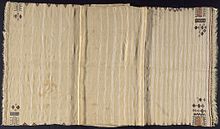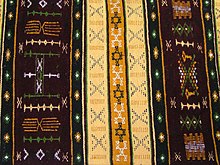Berber carpet
As a Berber carpet most of the be Maghreb -Staaten Morocco , Algeria , Tunisia and Libya monochrome manufactured or with traditional motifs (z. B. triangles, diamonds, etc.) denotes decorated carpets. Originally they were pure woven carpets ; Knotting techniques did not appear in the regions inhabited by Berbers until the 20th century. There were and still are regional differences and peculiarities in colors and patterns.
Historical and sociocultural background
Until well into the 20th century - in some cases even up to the present day - numerous Berber families led a nomadic or semi-nomadic life ( transhumance ) and roamed the country with their herds of cattle (donkeys, sheep, goats, more rarely camels) in search of food . While settling down gradually began in the oasis valleys , survival in the drier regions (especially in the Anti-Atlas ) was only possible if you had harvested barley , field beans , peas, etc., usually in March and April took place, moved the cattle to the mountain regions of the High Atlas , where grasses, herbs and above all water were still available in sufficient quantities. They only returned to their native villages in late autumn; During the absence, the property was stored in communal warehouses ( Agadiren ) and defended against attacks by other nomads and hostile neighboring villages by a guards who stayed at home.
The wandering nomads or semi-nomads lived in tents that were easy to set up, dismantle and transport , and which had to be insulated against the nightly cold ground as well as against wind and sandstorms. Blankets and carpets were an effective means of doing this - they were made by women of earlier times on simple hip looms; the resulting strips were then sewn together by hand to form larger areas. Stationary and wider looms did not come into use in the Berber regions until the middle of the 20th century.
Carpets
Traditional carpets
Hard-wearing carpets and blankets (the transitions are flowing), but also other items of clothing were without exception woven from sheep's wool ; during the weaving traditional geometric motifs such as triangles, diamonds or combs, as also on the outer walls of many of rammed earth made residential castles ( tighremts found), woven - animal motifs are rare. In contrast to the cities that were mostly inhabited by Arabs, colors only played a role late; Characteristic features of older or traditional carpets are therefore large, mostly white areas on which the almost black patterns made of dark sheep's wool or goat hair are only sparsely distributed.
Newer carpets
Younger 'Berber carpets' often still use the traditional patterns; However, they are overall significantly larger and more colorful and are often knotted. Unlike the older carpets, the entire surface is often decorated in a horror-vacui manner.
literature
- Bruno Barbatti: Tapis berbères du Maroc: la symbolique, origines et significations. ACR Édition, Paris 2006, ISBN 2-86770-180-5 .
- Helmut Reinisch and Wilfried Stanzer: Berber, tribal carpets and textiles from the Kingdom of Morocco. Self-published, Graz 1991, ISBN 3-9500132-0-2 .


